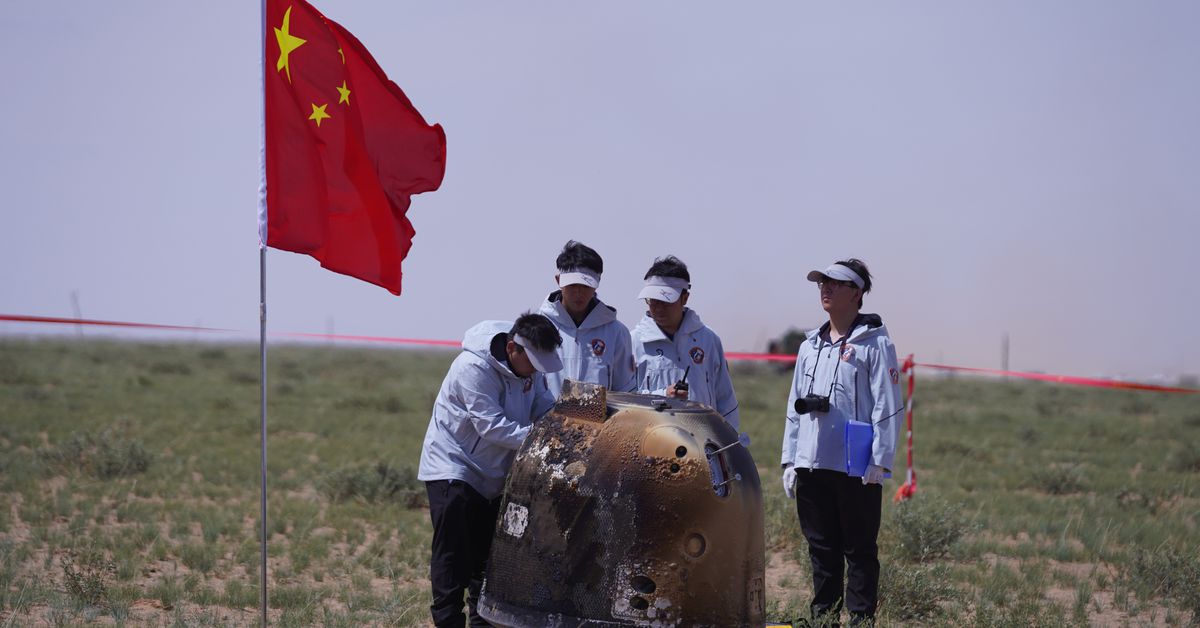Chang’e 6: Testing the Origin Story of the Moon by Floating on an Inner Mongolian Lava Flow with a Lunar Probe
A Chinese probe has returned to earth to Earth carrying the first samples ever taken from the far side of the moon. State television broadcast images of a capsule floating down with samples as it floated onto a grassy patch of Inner Mongolia.
Earlier this month it used a drill and scoop to collect samples from a lava flow in an area known as the South Pole-Aitken Basin. Carlson, who is an emeritus researcher at Carnegie Science in Washington DC, says these new samples should confirm the Apollo-era origin story — that the entire moon was forged quickly around 4.5 billion years ago.
The theory is widely accepted today, but the evidence remains somewhat limited. That’s because the Apollo missions (as well as the Soviet Union’s robotic Luna missions) all landed on the near side of the moon — the one that always faces the Earth.
China’s latest robotic probe, called Chang’e 6, landed on the far side of the moon. That’s a much more challenging task because the far side faces away from our planet and there’s no direct way to communicate. Chang’e 6 relied upon a satellite to relay its signal.
If the Chang’e 6 sample “gives the same age as the stuff from Apollo… then the likelihood is that you’re really looking at a global event,” he says. If not, then the textbooks will have to be rewritten again.
The Moon’s Far Side: A Puzzle for Planetary Scientists and the U.S., but What Happens When We Reconstruct the Moon
Jim Head is a planetary scientist at Brown University and he says that the far side of the moon has many mysteries as well. Unlike the near side, he says, the far side appears devoid of lava-flooded areas known as “maria”.
There are many differences on the far side and near side. It is a critical issue. The origin of a planet that has both hemispheres cannot be understood.
China and the U.S. are in competition with each other these days, including over the moon. The nations say that they want humans back on the lunar surface by the end of the decade.
But China has also offered to share at least some of its new moon samples with American researchers, and NASA is allowing the U.S. scientists to submit proposals. Carlson is all for it:
The feat is expected to help scientists better understand the unfamiliar terrain of the Moon’s far side and perhaps shed some light on the early history of the Moon and Earth. This is a significant milestone in the global space race to establish a presence on the Moon.
The Past, Present and Future of the Moon as witnessed by the late heavy bombardment, and the emergence of organic materials for life on Earth
President Xi Jinping congratulated the China National Space Administration, calling it a “landmark achievement in our country’s efforts at becoming a space and technological power,” according to The Associated Press.
The South Pole– Aitken Basin is a massive impact crater, formed around 4.26 billion years ago. The far side of the Moon ispockmarked with ancient craters that were caused by previous crashes. What materials the craters hold are important questions for figuring out how the Moon came to be.
The idea that asteroids brought water and organic materials to earth during the Late Heavy Bombardment has implications for understanding the origins of life on Earth according to a post by The Planetary Society. There has been more scrutiny into how brutal the bombardment was. Some questions could be answered by the long-awaited samples from the far side of the Moon.
China plans to send its Chang’e 7 spacecraft to the Moon’s south pole in 2026 to search for water and other resources that could potentially support long-term missions on the Moon. NASA wants to send the first humans to the lunar south pole region in 2026 as part of its Artemis III mission.
